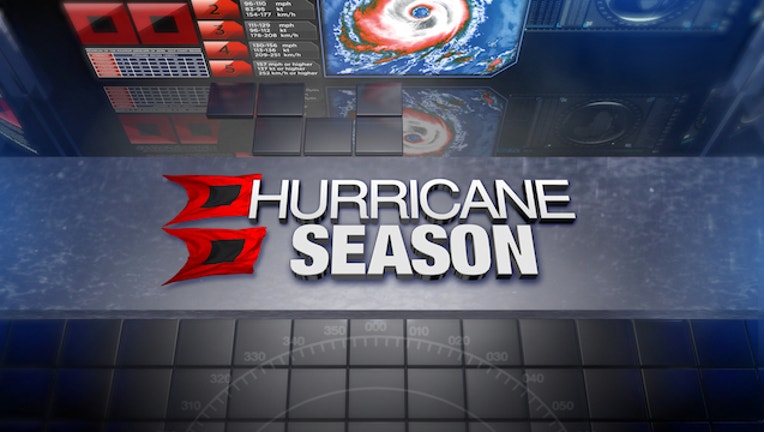Hurricane basics

Houston (FOX 26) - · A HURRICANE WATCH issued for your part of the coast indicates the possibility that you could experience hurricane conditions within 48 hours. This watch should trigger your family's disaster plan, and protective measures should be initiated, especially those actions that require extra time such as securing a boat, leaving a barrier island, etc.
Know What to Do When a Hurricane WATCH Is Issued
- Listen to NOAA Weather Radio or local radio or TV stations for up-to-date storm information. Go to reliable weather app or local media apps.
- Prepare to bring inside any lawn furniture, outdoor decorations or ornaments, trash cans, hanging plants, and anything else that can be picked up by the wind.
- Prepare to cover all windows of your home. If shutters have not been installed, use precut plywood as described above. Note: Tape does not prevent windows from breaking, so taping windows is not recommended.
- Fill your car's gas tank.
- Recheck manufactured home tie-downs.
- Check batteries and stock up on canned food, first aid supplies, drinking water, and medications.
· A HURRICANE WARNING issued for your part of the coast indicates that sustained winds of at least 74 mph are
expected within 36 hours or less. Once this warning has been issued, your family should be in the process of completing
protective actions and deciding the safest location to be during the storm.
Know What to Do When a Hurricane WARNING Is Issued
- Listen to the advice of local officials, and leave if they tell you to do so.
- Complete preparation activities.
- If you are not advised to evacuate, stay indoors, away from windows.
- Be aware that the calm "eye" is deceptive; the storm is not over. The worst part of the storm will happen once the eye passes over and the winds blow from the opposite direction. Trees, shrubs, buildings, and other objects damaged by the first winds can be broken or destroyed by the second winds.
- Be alert for tornadoes. Tornadoes can happen during a hurricane and after it passes over. Remain indoors, in the center of your home, in a closet or bathroom without windows.
- Stay away from flood waters. If you come upon a flooded road, turn around and go another way. If you are caught on a flooded road and waters are rising rapidly around you, get out of the car and climb to higher ground.
The ingredients for a hurricane include a pre-existing weather disturbance, warm tropical oceans, moisture, and relatively light winds aloft. If the right conditions persist long enough, they can combine to produce the violent winds, incredible waves, torrential rains, and floods we associate with this phenomenon.
Each year, an average of ten tropical storms develop over the Atlantic Ocean, Caribbean Sea, and Gulf of Mexico. Many of these remain over the ocean and never impact the U.S. coastline. On average six of these storms become hurricanes each year.
What is a Hurricane?
A hurricane is a type of tropical cyclone, which is a generic term for a low pressure system that generally forms in the tropics. The cyclone is accompanied by thunderstorms and, in the Northern Hemisphere, a counterclockwise circulation of winds near the earth's surface.
Hurricanes are categorized according to the strength of their winds using the Saffir-Simpson Hurricane Scale. A Category 1 storm has the lowest wind speeds, while a Category 5 hurricane has the strongest. These are relative terms, because lower category storms can sometimes inflict greater damage than higher category storms, depending on where they strike and the particular hazards they bring. In fact, tropical storms can also produce significant damage and loss of life, mainly due to flooding.
Tropical Depression
An organized system of clouds and thunderstorms with a defined surface circulation and maximum sustained winds* of 38 mph (33 kt**) or less
Tropical Storm
An organized system of strong thunderstorms with a defined surface circulation and maximum sustained winds of 39-73 mph (34-63 kt)
Hurricane Threats
Storm Surge – Storm surge is an abnormal rise of water generated by a storm, over and above the predicted astronomical tides. This rise in water level can cause extreme flooding in coastal areas resulting in storm tides reaching up to 20 feet or more in some cases. Along the Texas coast, these flood waters can penetrate far inland depending on the elevation of the land. If the storm tied is greater than the land elevation (even if well inland) then storm surge flooding will be possible.
Tornadoes & Destructive Winds – Tropical cyclones also produce tornadoes. These tornadoes most often occur in thunderstorms embedded in rain bands well away from the center of the hurricane; however, they can also occur near the eyewall. Tornadoes produced by tropical cyclones are relatively weak and short lived, but still pose a threat. Hurricane force winds of 74 mph or more can destroy buildings, mobile homes, trees and power poles. Debris such as signs, roofing material, siding and small items left outside become flying missiles in a hurricane. The strongest winds occur in a region of the hurricane called the eyewall. Wind gusts in the right side of the eyewall are the most destructive. Hurricane force winds can be felt as far as 150 miles from the coast.

